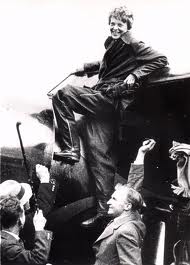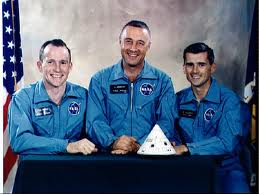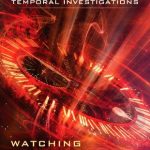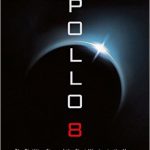 The Space Shuttle Atlantis is in the midst of her final flight. And it’s also the last scheduled manned mission of the U.S. space program. NASA’s future launches are all for satellites and rockets. Very pretty, but people’s hopes and dreams follow people, not hardware. Our hearts lift when they can ride the wings of another’s fulfilled dream, and imagine ourselves at their side, or in their place.
The Space Shuttle Atlantis is in the midst of her final flight. And it’s also the last scheduled manned mission of the U.S. space program. NASA’s future launches are all for satellites and rockets. Very pretty, but people’s hopes and dreams follow people, not hardware. Our hearts lift when they can ride the wings of another’s fulfilled dream, and imagine ourselves at their side, or in their place.
I’ve been re-watching Star Trek: Enterprise recently. While opinions on the series itself may vary, what still grabs me is the montage of images in the opening title sequence. If you always skipped that part, watch it again carefully. Ignore the music if you feel you must.
What gets me every time is that all of the images consist of archival footage up until the last few, when the sequence changes by showing the International Space Station as it should look when it is complete. But all the images, real and science fictional, show humankind’s relentless pursuit of what is beyond the next hill, what is on the other side of the fathomless depths of the ocean, what is out in the vast depths of space.
 There are reproductions of old maps of the earth including navigational charts. A shot of Thor Heyerdahl’s raft voyage across the Pacific Ocean on the Kon-Tiki. The Wright brothers’ first successful flight at Kitty Hawk. Amelia Earhart waving “good-bye,”possibly for the final time. Charles Lindbergh next to his famous plane, The Spirit of St. Louis, which is preserved at the National Air and Space Museum. A scene of Robert Goddard, the father of modern rocketry, writing his theories on a blackboard. Chuck Yeager striding away from the experimental aircraft with which he broke the sound barrier. Pictures of a succession of historic ships which all bore the name “Enterprise”, culminating in the experimental Space Shuttle Enterprise in 1977. The crew of Apollo 11 boarding their spacecraft, and then that “one small step for mankind”. A closeup of the Mars Rover exploring. And, a shuttle crew in flight and on a spacewalk.
There are reproductions of old maps of the earth including navigational charts. A shot of Thor Heyerdahl’s raft voyage across the Pacific Ocean on the Kon-Tiki. The Wright brothers’ first successful flight at Kitty Hawk. Amelia Earhart waving “good-bye,”possibly for the final time. Charles Lindbergh next to his famous plane, The Spirit of St. Louis, which is preserved at the National Air and Space Museum. A scene of Robert Goddard, the father of modern rocketry, writing his theories on a blackboard. Chuck Yeager striding away from the experimental aircraft with which he broke the sound barrier. Pictures of a succession of historic ships which all bore the name “Enterprise”, culminating in the experimental Space Shuttle Enterprise in 1977. The crew of Apollo 11 boarding their spacecraft, and then that “one small step for mankind”. A closeup of the Mars Rover exploring. And, a shuttle crew in flight and on a spacewalk.
 A friend wrote of the end of the Shuttle Program that the spirits of those who perished in the Challenger and Columbia disasters could finally rest in peace now. I firmly believe that he is wrong. Those who gave their lives in the space program, on Challenger, and Columbia, and with the first Apollo disaster at the beginning of the program, made their sacrifice so that humankind could reach further, so we could make our way into the stars. Those astronauts dreamed of space, not safety.
A friend wrote of the end of the Shuttle Program that the spirits of those who perished in the Challenger and Columbia disasters could finally rest in peace now. I firmly believe that he is wrong. Those who gave their lives in the space program, on Challenger, and Columbia, and with the first Apollo disaster at the beginning of the program, made their sacrifice so that humankind could reach further, so we could make our way into the stars. Those astronauts dreamed of space, not safety.
The quote from William Shedd still says it best. “A ship is safe in harbor, but that’s not what ships are for.” Humankind is not made to be safe. We are made to be explorers. Why have we stopped?









SciFans of an age have mostly two kinds of literature we remember. One is the space operas–tales of daring where humans can travel FTL and off we go and have adventures and, in better stories, probe the human condition in those imaginary circumstances.
Then there is a smaller lyric expression of what has been called “horizon fever” and which it seems to me you are getting at here. That is, very human desire to see what is over the horizon in the dreams of space.
Of course, this cosmology of two choices misses the “other”–there is always an other but, he said, leaving that for later…
Those of us with horizon fever often hear the tugging, siren call of space. Many of us want to go…and some: real soon now. I think those kinds of folks are conflicted about this last shuttle launch. What will follow? Will we get to space? Will *I* get to space? And that gets into politics and not the *is* of space so much as the *should* and the *how.* This post is evocative in probing these questions.
The SciFi that deals with horizon fever has to be metaphorical and I think lyric quality–it is the poetry of space and of horizon fever. If I recollect correctly from some years ago, my first reading of Arthur C. Clarke’s Earthlight, it begins with a monorail ride on the moon.
Clarke was arguably the greatest stylist of SciFi and this description is compelling. From one point to the other on the moon which now has cities and commerce, in and out of the shadows, and on to the story I know longer remember… And not one second since reading that have I not wanted to go to space.
Our host a few posts ago mentioned Heinlein’s Moon is a Harsh Mistress which is an extraordinary book where the inhabitants of the moon revolt from the control of the distant Earth government. Very 1776 when they reach the “if they mean to have a war, let it begin here” moment.
Heinlein was one of the giants of SciFi and is not normally thought of as what I have called here “lyric” but he did two short stories that are: Requiem and The Green Hills of Earth. Requiem is the sequel to The Man Who Sold the Moon–the Heinlein uber capitalist who got humans to the moon by selling it as a capitalist but he was never allowed to go because he was too important. In Requiem, he makes it and we realize that he was driven not by money he made as an evil capitalist but by the dreams of space. It is a story that compels one to reflect.
In The Green Hills of Earth we follow a cranky space poet (Rhysling)–a wonderful thought that we will have them–in his last poem when he realizes he will never see home again.
We pray for one last landing
On the globe that gave us birth.
Let us rest our eyes on the fleecy skies
And the cool green hills of Earth.
Luck guy, Rhysling. In the poem he says he wants to get back to Earth. Me? I would love to see Saturn’s rings and I don’t think NASA will get me there.
drdata